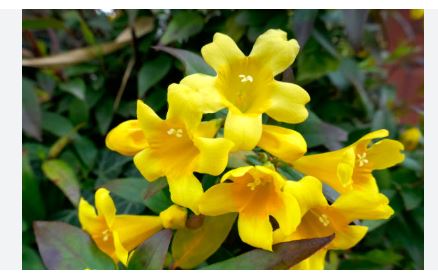
Gelsemium sempervirens, commonly known as Yellow Jessamine or Carolina Jessamine, is part of the Gelsemium genus within the Gelsemiaceae family. This species is notable for its vibrant, funnel-shaped, yellow flowers that bloom in clusters. Previously, it was classified under the Loganiaceae family, but recent taxonomic studies have placed it in its own family, reflecting its unique characteristics. The name “Gelsemium” derives from the Italian word for jasmine, “gelsomino,” while “sempervirens” means “evergreen,” indicating its perennial, leafy nature.
Yellow Jessamine is native to the southeastern United States, with its range extending from Virginia south to Florida and west to Texas, including parts of Arkansas and Oklahoma. It’s commonly found in woodland edges, thickets, and along roadsides, thriving in the humid, temperate conditions of the region. Its ability to grow in various soil types, from sandy to rich loam, makes it quite adaptable within its native range.
Historically, Gelsemium sempervirens has had both cultural and medicinal significance. It was named the state flower of South Carolina in 1924, reflecting its widespread beauty across the state. Indigenous peoples used it for medicinal purposes, although with caution due to its toxicity. In the 19th and early 20th centuries, extracts from Yellow Jessamine were used in medicine, notably as a sedative or treatment for neuralgia, but its use diminished as its potential toxicity became better understood. Despite this, it has remained popular in gardening for its ornamental value, offering a bright display in early spring when few other plants are flowering. Its beauty is balanced by its danger, as all parts of the plant are poisonous if ingested, necessitating careful handling and placement in landscapes.
Yellow Jessamine is well-suited to USDA Hardiness Zones 7 through 10. This range reflects its preference for a warm, humid climate, where it can grow as both a vine or groundcover, thriving in full sun to partial shade. Its versatility in growth form, ability to climb or sprawl, and its evergreen foliage make it a valuable plant for landscapes seeking year-round interest. However, its cultivation should consider its toxicity, ensuring it’s not accessible to children or pets, and it’s particularly appreciated in the Southeast US for its early floral display and fragrance.
Yellow Jessamine (Gelsemium sempervirens): Characteristics
- Flower Appearance: Displays showy, trumpet-shaped, bright yellow flowers that bloom in clusters, offering a striking contrast against its foliage. Each flower has five petals and a sweet fragrance.
- Bloom Time: Blooms early in the year, often from late winter through early spring, sometimes even into summer, providing one of the first splashes of color in the garden season.
- Growth Habit: A versatile plant that can grow as a vine, climbing up to 20 feet or more with support, or as a sprawling ground cover if not provided a structure to climb. It’s evergreen in warmer climates.
- Leaves: Leaves are glossy, dark green, and lance-shaped, arranged in an opposite pattern along the stem. They contribute to the plant’s year-round ornamental value.
- Root System: Has a fibrous root system, making it adaptable to various soil types but also somewhat invasive in ideal conditions, as it can spread through underground roots.
- Adaptability: Highly adaptable to different soil types, including sandy, loamy, or clay soils, provided they are well-drained. Prefers full sun to partial shade for optimal flowering.
- Pollinator Attraction: Attracts bees, butterflies, and hummingbirds with its nectar, contributing to local biodiversity and pollination, despite its toxicity to mammals.
- Fragrance: Emits a sweet, jasmine-like scent, especially potent in the morning or evening, which adds to its appeal in gardens but requires careful placement due to its toxic nature.
- Toxicity: All parts of the plant are toxic if ingested, containing alkaloids like gelsemine, which can cause severe symptoms if consumed. This necessitates careful handling and placement away from pets and children.
- Ecological Role: Provides habitat and nectar for pollinators while also acting as a cover plant in natural settings. Its growth can help prevent soil erosion in areas where it’s appropriately managed.
Yellow Jessamine (Gelsemium sempervirens): Cultivation
Site Selection
Choose a location with full sun to partial shade. Yellow Jessamine blooms best with at least 6 hours of direct sunlight but can tolerate some shade, especially in the South where the sun is intense.
Soil Preparation
Prefers well-drained soil but is adaptable to various types, including sandy, loamy, or clay soils. Enhance drainage in heavy soils by adding organic matter or sand.
Planting
Plant in spring or fall. Provide a trellis, arbor, or wall for support if growing as a vine, or allow it to spread as ground cover. Space plants about 3-6 feet apart to account for growth.
Watering:
Water regularly until established, then reduce frequency as it’s somewhat drought-tolerant. Overwatering can lead to root rot, so ensure good drainage.
Mulching
Apply a thin layer of mulch to conserve soil moisture and suppress weeds, but keep it away from the stem base to prevent moisture buildup that might encourage rot.
Fertilization
Fertilize sparingly; once or twice a year in early spring with a balanced, slow-release fertilizer. Over-fertilization can lead to excessive foliage at the expense of flowers.
Pruning and Maintenance
Prune after blooming to shape or control growth, as it can be vigorous. Remove dead or damaged branches anytime. Wear gloves due to the plant’s toxicity.
Pest and Disease Management
Generally resistant to pests, but watch for aphids or scale. Fungal diseases can occur with poor air circulation; prune to open up the plant if needed. Use caution with any treatment due to the plant’s poisonous nature.
Propagation
Can be propagated by seeds, which require stratification, or more commonly by softwood cuttings taken in late spring or early summer. Root cuttings are another method, taken in fall or winter.
Winter Care
In its hardiness zones, no special winter care is generally needed as it’s evergreen and hardy. However, in colder areas within its range, a light mulch can offer protection against extreme cold snaps.